Business Law Report: Consumer Protection, Credit, and Competition Law
VerifiedAdded on 2020/01/28
|11
|3237
|77
Report
AI Summary
This business law report delves into several key areas of commercial law, starting with the Sale of Goods Act and its implications for transactions, including aspects of title, description, quality, and the transfer of goods. It analyzes scenarios involving breaches of contract and the remedies available to both buyers and sellers. The report then explores consumer protection, specifically the Consumer Protection Act 1987 and its application to faulty products. The Consumer Credit Act 1974 is examined, with a focus on credit agreements, termination rights, and the obligations of both creditors and debtors. The report also discusses different types of agents and their roles in commercial transactions, alongside an overview of competition law in the UK, including regulations concerning monopolies, mergers, and the application of EU exemptions. The report offers a comprehensive understanding of the legal framework governing business operations and consumer rights.
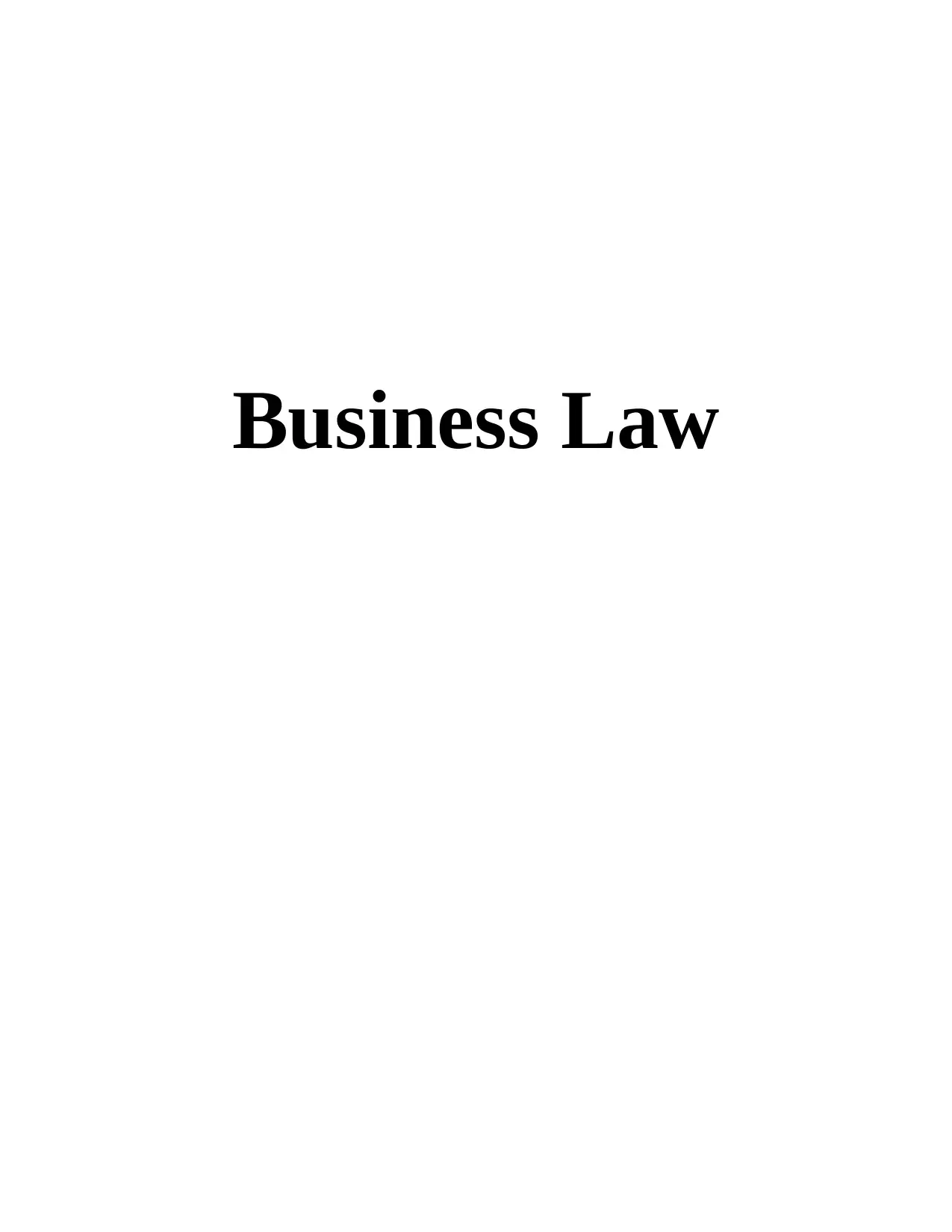
Business Law
Paraphrase This Document
Need a fresh take? Get an instant paraphrase of this document with our AI Paraphraser
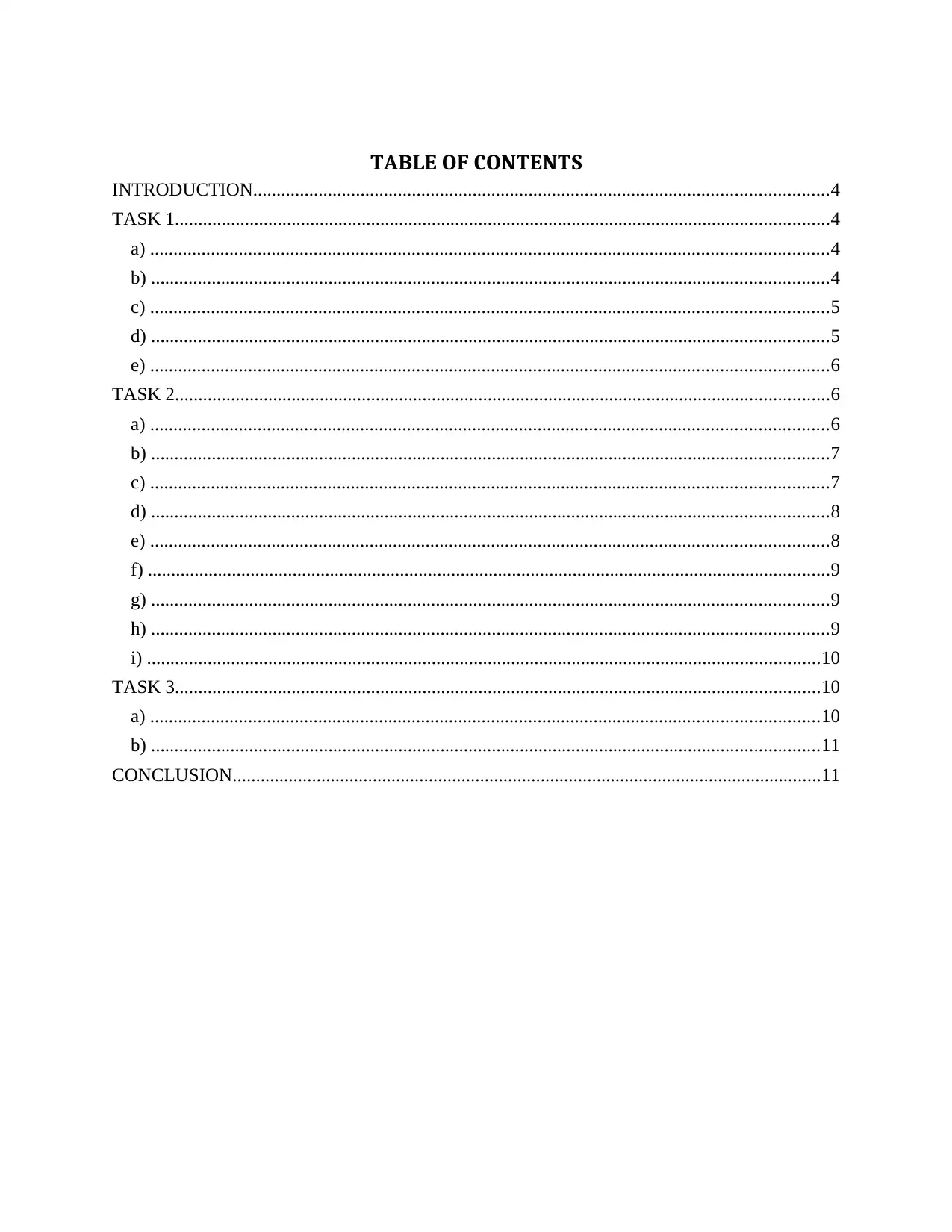
TABLE OF CONTENTS
INTRODUCTION...........................................................................................................................4
TASK 1............................................................................................................................................4
a) .................................................................................................................................................4
b) .................................................................................................................................................4
c) .................................................................................................................................................5
d) .................................................................................................................................................5
e) .................................................................................................................................................6
TASK 2............................................................................................................................................6
a) .................................................................................................................................................6
b) .................................................................................................................................................7
c) .................................................................................................................................................7
d) .................................................................................................................................................8
e) .................................................................................................................................................8
f) ..................................................................................................................................................9
g) .................................................................................................................................................9
h) .................................................................................................................................................9
i) ................................................................................................................................................10
TASK 3..........................................................................................................................................10
a) ...............................................................................................................................................10
b) ...............................................................................................................................................11
CONCLUSION..............................................................................................................................11
INTRODUCTION...........................................................................................................................4
TASK 1............................................................................................................................................4
a) .................................................................................................................................................4
b) .................................................................................................................................................4
c) .................................................................................................................................................5
d) .................................................................................................................................................5
e) .................................................................................................................................................6
TASK 2............................................................................................................................................6
a) .................................................................................................................................................6
b) .................................................................................................................................................7
c) .................................................................................................................................................7
d) .................................................................................................................................................8
e) .................................................................................................................................................8
f) ..................................................................................................................................................9
g) .................................................................................................................................................9
h) .................................................................................................................................................9
i) ................................................................................................................................................10
TASK 3..........................................................................................................................................10
a) ...............................................................................................................................................10
b) ...............................................................................................................................................11
CONCLUSION..............................................................................................................................11
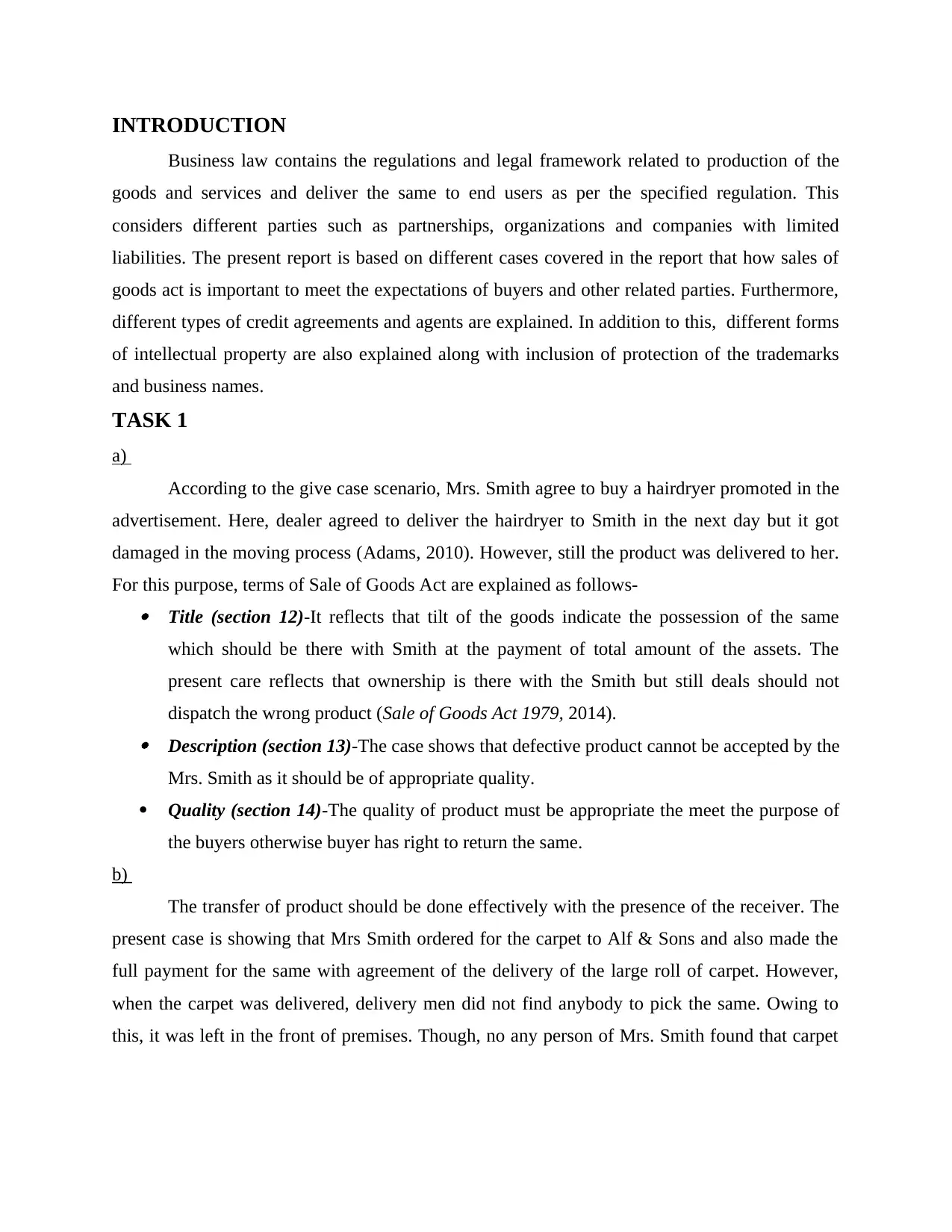
INTRODUCTION
Business law contains the regulations and legal framework related to production of the
goods and services and deliver the same to end users as per the specified regulation. This
considers different parties such as partnerships, organizations and companies with limited
liabilities. The present report is based on different cases covered in the report that how sales of
goods act is important to meet the expectations of buyers and other related parties. Furthermore,
different types of credit agreements and agents are explained. In addition to this, different forms
of intellectual property are also explained along with inclusion of protection of the trademarks
and business names.
TASK 1
a)
According to the give case scenario, Mrs. Smith agree to buy a hairdryer promoted in the
advertisement. Here, dealer agreed to deliver the hairdryer to Smith in the next day but it got
damaged in the moving process (Adams, 2010). However, still the product was delivered to her.
For this purpose, terms of Sale of Goods Act are explained as follows- Title (section 12)-It reflects that tilt of the goods indicate the possession of the same
which should be there with Smith at the payment of total amount of the assets. The
present care reflects that ownership is there with the Smith but still deals should not
dispatch the wrong product (Sale of Goods Act 1979, 2014). Description (section 13)-The case shows that defective product cannot be accepted by the
Mrs. Smith as it should be of appropriate quality.
Quality (section 14)-The quality of product must be appropriate the meet the purpose of
the buyers otherwise buyer has right to return the same.
b)
The transfer of product should be done effectively with the presence of the receiver. The
present case is showing that Mrs Smith ordered for the carpet to Alf & Sons and also made the
full payment for the same with agreement of the delivery of the large roll of carpet. However,
when the carpet was delivered, delivery men did not find anybody to pick the same. Owing to
this, it was left in the front of premises. Though, no any person of Mrs. Smith found that carpet
Business law contains the regulations and legal framework related to production of the
goods and services and deliver the same to end users as per the specified regulation. This
considers different parties such as partnerships, organizations and companies with limited
liabilities. The present report is based on different cases covered in the report that how sales of
goods act is important to meet the expectations of buyers and other related parties. Furthermore,
different types of credit agreements and agents are explained. In addition to this, different forms
of intellectual property are also explained along with inclusion of protection of the trademarks
and business names.
TASK 1
a)
According to the give case scenario, Mrs. Smith agree to buy a hairdryer promoted in the
advertisement. Here, dealer agreed to deliver the hairdryer to Smith in the next day but it got
damaged in the moving process (Adams, 2010). However, still the product was delivered to her.
For this purpose, terms of Sale of Goods Act are explained as follows- Title (section 12)-It reflects that tilt of the goods indicate the possession of the same
which should be there with Smith at the payment of total amount of the assets. The
present care reflects that ownership is there with the Smith but still deals should not
dispatch the wrong product (Sale of Goods Act 1979, 2014). Description (section 13)-The case shows that defective product cannot be accepted by the
Mrs. Smith as it should be of appropriate quality.
Quality (section 14)-The quality of product must be appropriate the meet the purpose of
the buyers otherwise buyer has right to return the same.
b)
The transfer of product should be done effectively with the presence of the receiver. The
present case is showing that Mrs Smith ordered for the carpet to Alf & Sons and also made the
full payment for the same with agreement of the delivery of the large roll of carpet. However,
when the carpet was delivered, delivery men did not find anybody to pick the same. Owing to
this, it was left in the front of premises. Though, no any person of Mrs. Smith found that carpet
⊘ This is a preview!⊘
Do you want full access?
Subscribe today to unlock all pages.

Trusted by 1+ million students worldwide
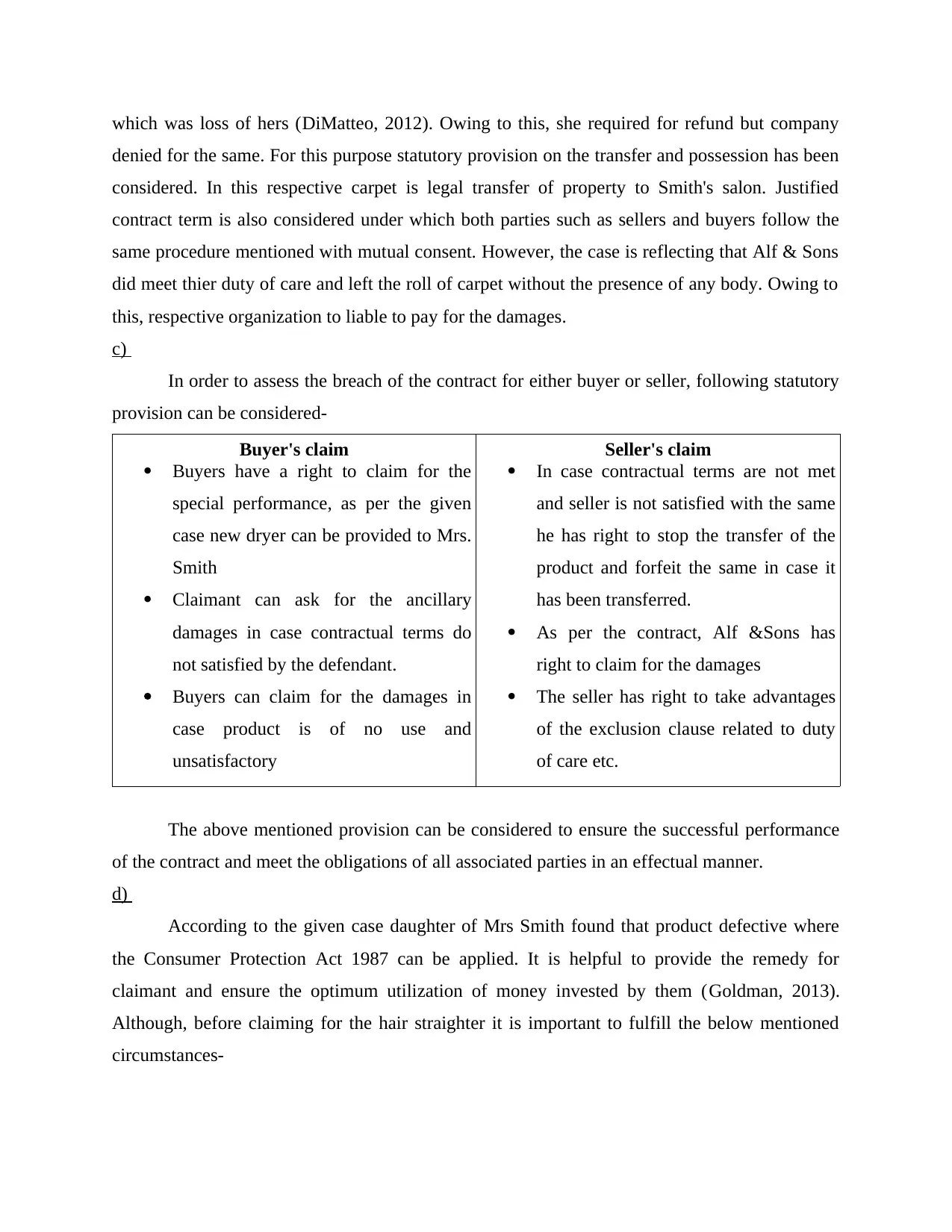
which was loss of hers (DiMatteo, 2012). Owing to this, she required for refund but company
denied for the same. For this purpose statutory provision on the transfer and possession has been
considered. In this respective carpet is legal transfer of property to Smith's salon. Justified
contract term is also considered under which both parties such as sellers and buyers follow the
same procedure mentioned with mutual consent. However, the case is reflecting that Alf & Sons
did meet thier duty of care and left the roll of carpet without the presence of any body. Owing to
this, respective organization to liable to pay for the damages.
c)
In order to assess the breach of the contract for either buyer or seller, following statutory
provision can be considered-
Buyer's claim
Buyers have a right to claim for the
special performance, as per the given
case new dryer can be provided to Mrs.
Smith
Claimant can ask for the ancillary
damages in case contractual terms do
not satisfied by the defendant.
Buyers can claim for the damages in
case product is of no use and
unsatisfactory
Seller's claim
In case contractual terms are not met
and seller is not satisfied with the same
he has right to stop the transfer of the
product and forfeit the same in case it
has been transferred.
As per the contract, Alf &Sons has
right to claim for the damages
The seller has right to take advantages
of the exclusion clause related to duty
of care etc.
The above mentioned provision can be considered to ensure the successful performance
of the contract and meet the obligations of all associated parties in an effectual manner.
d)
According to the given case daughter of Mrs Smith found that product defective where
the Consumer Protection Act 1987 can be applied. It is helpful to provide the remedy for
claimant and ensure the optimum utilization of money invested by them (Goldman, 2013).
Although, before claiming for the hair straighter it is important to fulfill the below mentioned
circumstances-
denied for the same. For this purpose statutory provision on the transfer and possession has been
considered. In this respective carpet is legal transfer of property to Smith's salon. Justified
contract term is also considered under which both parties such as sellers and buyers follow the
same procedure mentioned with mutual consent. However, the case is reflecting that Alf & Sons
did meet thier duty of care and left the roll of carpet without the presence of any body. Owing to
this, respective organization to liable to pay for the damages.
c)
In order to assess the breach of the contract for either buyer or seller, following statutory
provision can be considered-
Buyer's claim
Buyers have a right to claim for the
special performance, as per the given
case new dryer can be provided to Mrs.
Smith
Claimant can ask for the ancillary
damages in case contractual terms do
not satisfied by the defendant.
Buyers can claim for the damages in
case product is of no use and
unsatisfactory
Seller's claim
In case contractual terms are not met
and seller is not satisfied with the same
he has right to stop the transfer of the
product and forfeit the same in case it
has been transferred.
As per the contract, Alf &Sons has
right to claim for the damages
The seller has right to take advantages
of the exclusion clause related to duty
of care etc.
The above mentioned provision can be considered to ensure the successful performance
of the contract and meet the obligations of all associated parties in an effectual manner.
d)
According to the given case daughter of Mrs Smith found that product defective where
the Consumer Protection Act 1987 can be applied. It is helpful to provide the remedy for
claimant and ensure the optimum utilization of money invested by them (Goldman, 2013).
Although, before claiming for the hair straighter it is important to fulfill the below mentioned
circumstances-
Paraphrase This Document
Need a fresh take? Get an instant paraphrase of this document with our AI Paraphraser
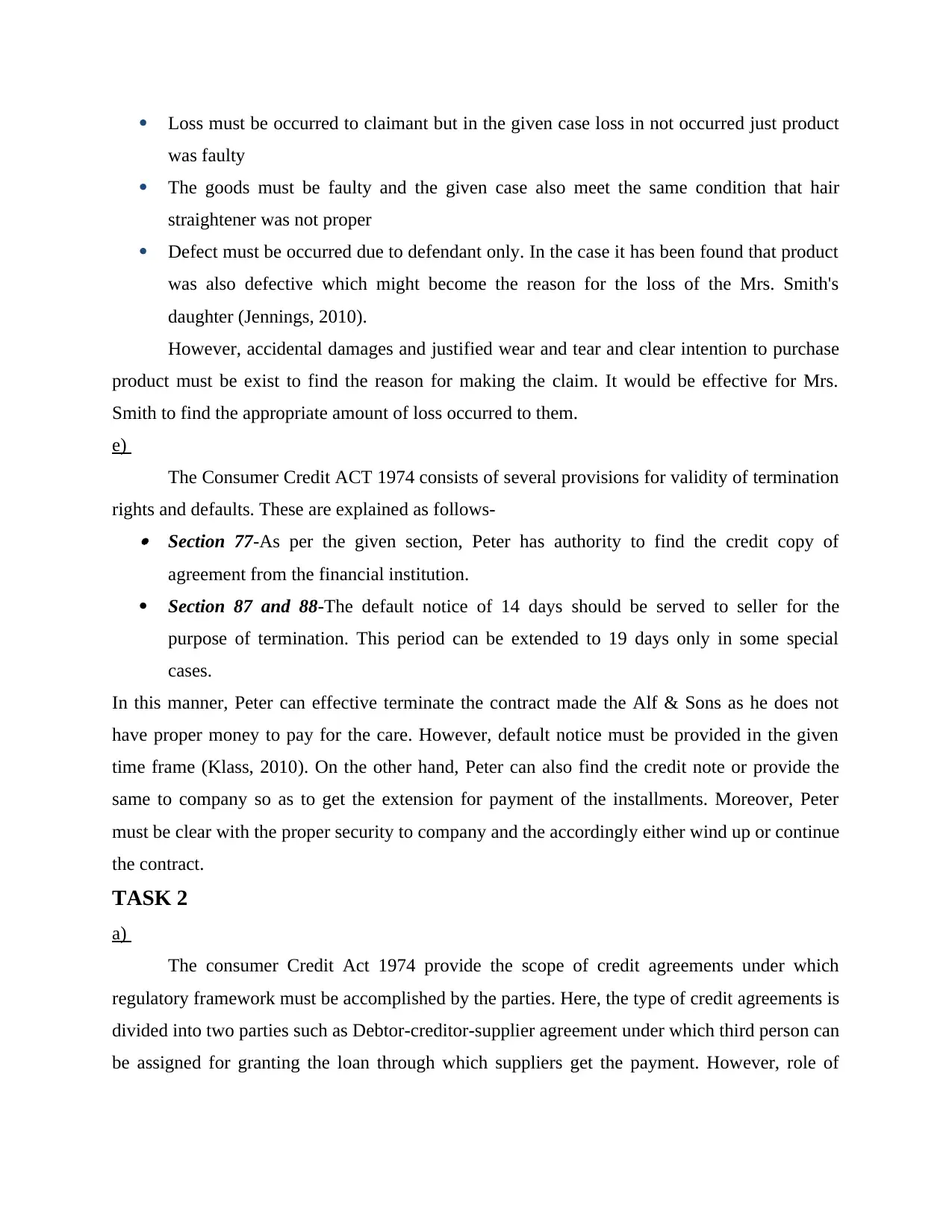
Loss must be occurred to claimant but in the given case loss in not occurred just product
was faulty
The goods must be faulty and the given case also meet the same condition that hair
straightener was not proper
Defect must be occurred due to defendant only. In the case it has been found that product
was also defective which might become the reason for the loss of the Mrs. Smith's
daughter (Jennings, 2010).
However, accidental damages and justified wear and tear and clear intention to purchase
product must be exist to find the reason for making the claim. It would be effective for Mrs.
Smith to find the appropriate amount of loss occurred to them.
e)
The Consumer Credit ACT 1974 consists of several provisions for validity of termination
rights and defaults. These are explained as follows- Section 77-As per the given section, Peter has authority to find the credit copy of
agreement from the financial institution.
Section 87 and 88-The default notice of 14 days should be served to seller for the
purpose of termination. This period can be extended to 19 days only in some special
cases.
In this manner, Peter can effective terminate the contract made the Alf & Sons as he does not
have proper money to pay for the care. However, default notice must be provided in the given
time frame (Klass, 2010). On the other hand, Peter can also find the credit note or provide the
same to company so as to get the extension for payment of the installments. Moreover, Peter
must be clear with the proper security to company and the accordingly either wind up or continue
the contract.
TASK 2
a)
The consumer Credit Act 1974 provide the scope of credit agreements under which
regulatory framework must be accomplished by the parties. Here, the type of credit agreements is
divided into two parties such as Debtor-creditor-supplier agreement under which third person can
be assigned for granting the loan through which suppliers get the payment. However, role of
was faulty
The goods must be faulty and the given case also meet the same condition that hair
straightener was not proper
Defect must be occurred due to defendant only. In the case it has been found that product
was also defective which might become the reason for the loss of the Mrs. Smith's
daughter (Jennings, 2010).
However, accidental damages and justified wear and tear and clear intention to purchase
product must be exist to find the reason for making the claim. It would be effective for Mrs.
Smith to find the appropriate amount of loss occurred to them.
e)
The Consumer Credit ACT 1974 consists of several provisions for validity of termination
rights and defaults. These are explained as follows- Section 77-As per the given section, Peter has authority to find the credit copy of
agreement from the financial institution.
Section 87 and 88-The default notice of 14 days should be served to seller for the
purpose of termination. This period can be extended to 19 days only in some special
cases.
In this manner, Peter can effective terminate the contract made the Alf & Sons as he does not
have proper money to pay for the care. However, default notice must be provided in the given
time frame (Klass, 2010). On the other hand, Peter can also find the credit note or provide the
same to company so as to get the extension for payment of the installments. Moreover, Peter
must be clear with the proper security to company and the accordingly either wind up or continue
the contract.
TASK 2
a)
The consumer Credit Act 1974 provide the scope of credit agreements under which
regulatory framework must be accomplished by the parties. Here, the type of credit agreements is
divided into two parties such as Debtor-creditor-supplier agreement under which third person can
be assigned for granting the loan through which suppliers get the payment. However, role of
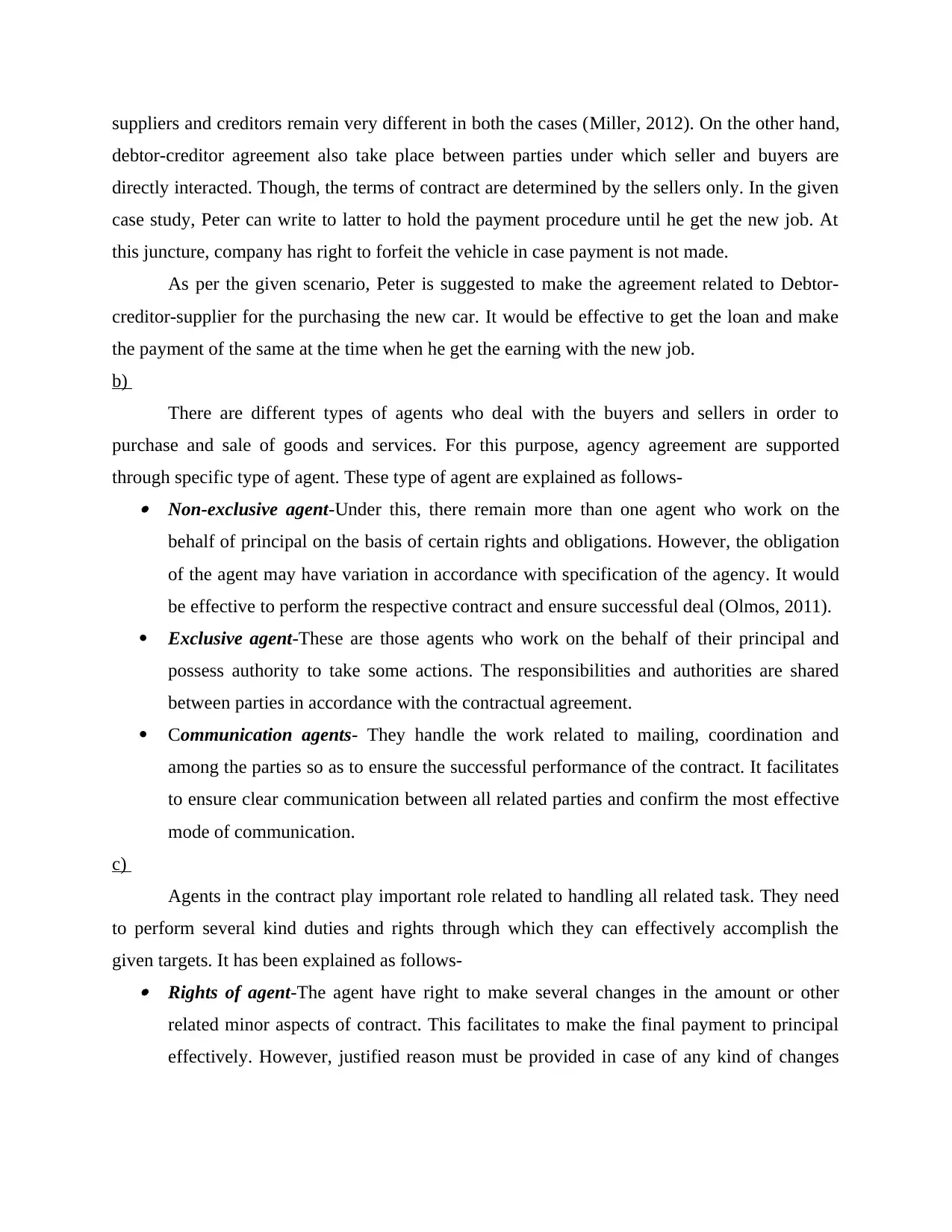
suppliers and creditors remain very different in both the cases (Miller, 2012). On the other hand,
debtor-creditor agreement also take place between parties under which seller and buyers are
directly interacted. Though, the terms of contract are determined by the sellers only. In the given
case study, Peter can write to latter to hold the payment procedure until he get the new job. At
this juncture, company has right to forfeit the vehicle in case payment is not made.
As per the given scenario, Peter is suggested to make the agreement related to Debtor-
creditor-supplier for the purchasing the new car. It would be effective to get the loan and make
the payment of the same at the time when he get the earning with the new job.
b)
There are different types of agents who deal with the buyers and sellers in order to
purchase and sale of goods and services. For this purpose, agency agreement are supported
through specific type of agent. These type of agent are explained as follows- Non-exclusive agent-Under this, there remain more than one agent who work on the
behalf of principal on the basis of certain rights and obligations. However, the obligation
of the agent may have variation in accordance with specification of the agency. It would
be effective to perform the respective contract and ensure successful deal (Olmos, 2011).
Exclusive agent-These are those agents who work on the behalf of their principal and
possess authority to take some actions. The responsibilities and authorities are shared
between parties in accordance with the contractual agreement.
Communication agents- They handle the work related to mailing, coordination and
among the parties so as to ensure the successful performance of the contract. It facilitates
to ensure clear communication between all related parties and confirm the most effective
mode of communication.
c)
Agents in the contract play important role related to handling all related task. They need
to perform several kind duties and rights through which they can effectively accomplish the
given targets. It has been explained as follows- Rights of agent-The agent have right to make several changes in the amount or other
related minor aspects of contract. This facilitates to make the final payment to principal
effectively. However, justified reason must be provided in case of any kind of changes
debtor-creditor agreement also take place between parties under which seller and buyers are
directly interacted. Though, the terms of contract are determined by the sellers only. In the given
case study, Peter can write to latter to hold the payment procedure until he get the new job. At
this juncture, company has right to forfeit the vehicle in case payment is not made.
As per the given scenario, Peter is suggested to make the agreement related to Debtor-
creditor-supplier for the purchasing the new car. It would be effective to get the loan and make
the payment of the same at the time when he get the earning with the new job.
b)
There are different types of agents who deal with the buyers and sellers in order to
purchase and sale of goods and services. For this purpose, agency agreement are supported
through specific type of agent. These type of agent are explained as follows- Non-exclusive agent-Under this, there remain more than one agent who work on the
behalf of principal on the basis of certain rights and obligations. However, the obligation
of the agent may have variation in accordance with specification of the agency. It would
be effective to perform the respective contract and ensure successful deal (Olmos, 2011).
Exclusive agent-These are those agents who work on the behalf of their principal and
possess authority to take some actions. The responsibilities and authorities are shared
between parties in accordance with the contractual agreement.
Communication agents- They handle the work related to mailing, coordination and
among the parties so as to ensure the successful performance of the contract. It facilitates
to ensure clear communication between all related parties and confirm the most effective
mode of communication.
c)
Agents in the contract play important role related to handling all related task. They need
to perform several kind duties and rights through which they can effectively accomplish the
given targets. It has been explained as follows- Rights of agent-The agent have right to make several changes in the amount or other
related minor aspects of contract. This facilitates to make the final payment to principal
effectively. However, justified reason must be provided in case of any kind of changes
⊘ This is a preview!⊘
Do you want full access?
Subscribe today to unlock all pages.

Trusted by 1+ million students worldwide
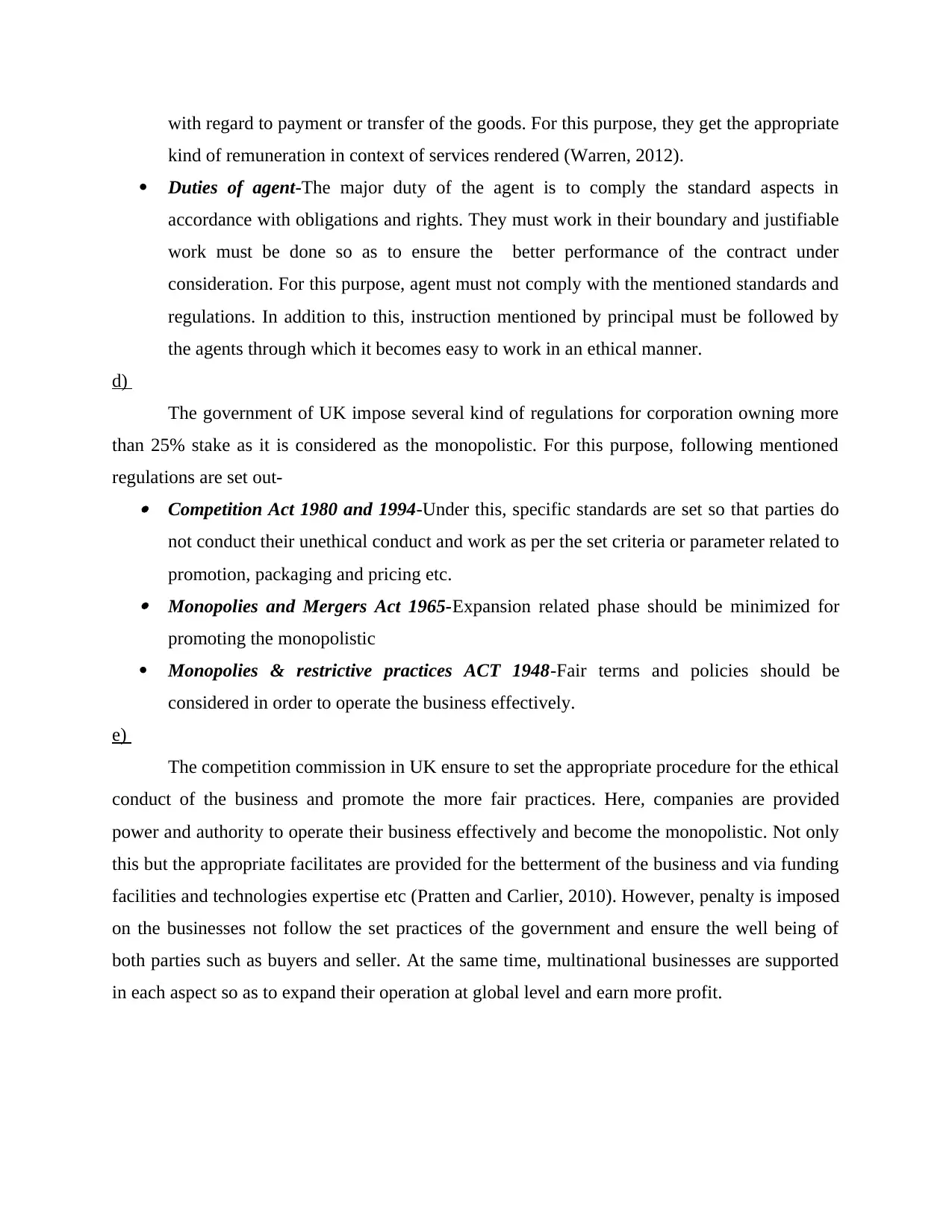
with regard to payment or transfer of the goods. For this purpose, they get the appropriate
kind of remuneration in context of services rendered (Warren, 2012).
Duties of agent-The major duty of the agent is to comply the standard aspects in
accordance with obligations and rights. They must work in their boundary and justifiable
work must be done so as to ensure the better performance of the contract under
consideration. For this purpose, agent must not comply with the mentioned standards and
regulations. In addition to this, instruction mentioned by principal must be followed by
the agents through which it becomes easy to work in an ethical manner.
d)
The government of UK impose several kind of regulations for corporation owning more
than 25% stake as it is considered as the monopolistic. For this purpose, following mentioned
regulations are set out- Competition Act 1980 and 1994-Under this, specific standards are set so that parties do
not conduct their unethical conduct and work as per the set criteria or parameter related to
promotion, packaging and pricing etc. Monopolies and Mergers Act 1965-Expansion related phase should be minimized for
promoting the monopolistic
Monopolies & restrictive practices ACT 1948-Fair terms and policies should be
considered in order to operate the business effectively.
e)
The competition commission in UK ensure to set the appropriate procedure for the ethical
conduct of the business and promote the more fair practices. Here, companies are provided
power and authority to operate their business effectively and become the monopolistic. Not only
this but the appropriate facilitates are provided for the betterment of the business and via funding
facilities and technologies expertise etc (Pratten and Carlier, 2010). However, penalty is imposed
on the businesses not follow the set practices of the government and ensure the well being of
both parties such as buyers and seller. At the same time, multinational businesses are supported
in each aspect so as to expand their operation at global level and earn more profit.
kind of remuneration in context of services rendered (Warren, 2012).
Duties of agent-The major duty of the agent is to comply the standard aspects in
accordance with obligations and rights. They must work in their boundary and justifiable
work must be done so as to ensure the better performance of the contract under
consideration. For this purpose, agent must not comply with the mentioned standards and
regulations. In addition to this, instruction mentioned by principal must be followed by
the agents through which it becomes easy to work in an ethical manner.
d)
The government of UK impose several kind of regulations for corporation owning more
than 25% stake as it is considered as the monopolistic. For this purpose, following mentioned
regulations are set out- Competition Act 1980 and 1994-Under this, specific standards are set so that parties do
not conduct their unethical conduct and work as per the set criteria or parameter related to
promotion, packaging and pricing etc. Monopolies and Mergers Act 1965-Expansion related phase should be minimized for
promoting the monopolistic
Monopolies & restrictive practices ACT 1948-Fair terms and policies should be
considered in order to operate the business effectively.
e)
The competition commission in UK ensure to set the appropriate procedure for the ethical
conduct of the business and promote the more fair practices. Here, companies are provided
power and authority to operate their business effectively and become the monopolistic. Not only
this but the appropriate facilitates are provided for the betterment of the business and via funding
facilities and technologies expertise etc (Pratten and Carlier, 2010). However, penalty is imposed
on the businesses not follow the set practices of the government and ensure the well being of
both parties such as buyers and seller. At the same time, multinational businesses are supported
in each aspect so as to expand their operation at global level and earn more profit.
Paraphrase This Document
Need a fresh take? Get an instant paraphrase of this document with our AI Paraphraser
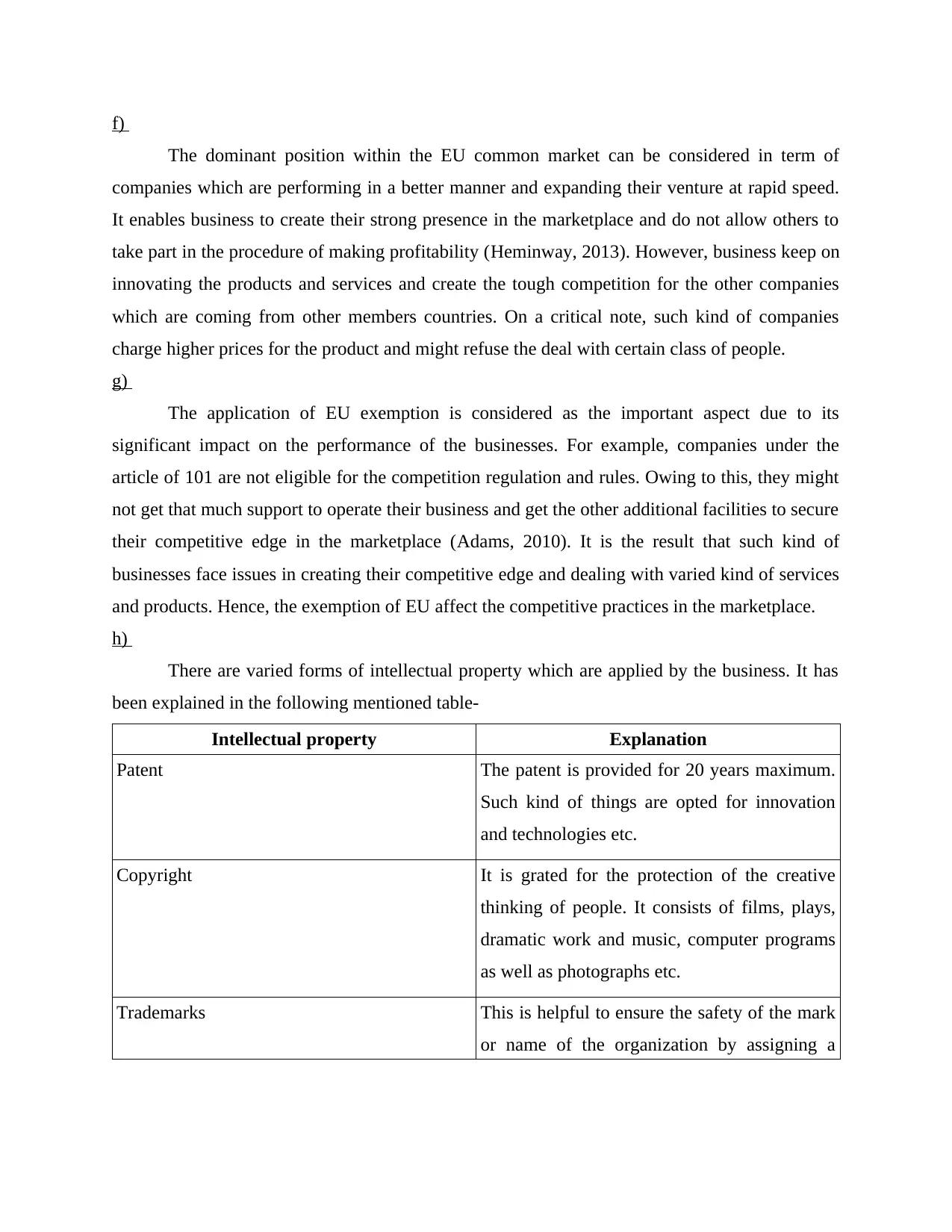
f)
The dominant position within the EU common market can be considered in term of
companies which are performing in a better manner and expanding their venture at rapid speed.
It enables business to create their strong presence in the marketplace and do not allow others to
take part in the procedure of making profitability (Heminway, 2013). However, business keep on
innovating the products and services and create the tough competition for the other companies
which are coming from other members countries. On a critical note, such kind of companies
charge higher prices for the product and might refuse the deal with certain class of people.
g)
The application of EU exemption is considered as the important aspect due to its
significant impact on the performance of the businesses. For example, companies under the
article of 101 are not eligible for the competition regulation and rules. Owing to this, they might
not get that much support to operate their business and get the other additional facilities to secure
their competitive edge in the marketplace (Adams, 2010). It is the result that such kind of
businesses face issues in creating their competitive edge and dealing with varied kind of services
and products. Hence, the exemption of EU affect the competitive practices in the marketplace.
h)
There are varied forms of intellectual property which are applied by the business. It has
been explained in the following mentioned table-
Intellectual property Explanation
Patent The patent is provided for 20 years maximum.
Such kind of things are opted for innovation
and technologies etc.
Copyright It is grated for the protection of the creative
thinking of people. It consists of films, plays,
dramatic work and music, computer programs
as well as photographs etc.
Trademarks This is helpful to ensure the safety of the mark
or name of the organization by assigning a
The dominant position within the EU common market can be considered in term of
companies which are performing in a better manner and expanding their venture at rapid speed.
It enables business to create their strong presence in the marketplace and do not allow others to
take part in the procedure of making profitability (Heminway, 2013). However, business keep on
innovating the products and services and create the tough competition for the other companies
which are coming from other members countries. On a critical note, such kind of companies
charge higher prices for the product and might refuse the deal with certain class of people.
g)
The application of EU exemption is considered as the important aspect due to its
significant impact on the performance of the businesses. For example, companies under the
article of 101 are not eligible for the competition regulation and rules. Owing to this, they might
not get that much support to operate their business and get the other additional facilities to secure
their competitive edge in the marketplace (Adams, 2010). It is the result that such kind of
businesses face issues in creating their competitive edge and dealing with varied kind of services
and products. Hence, the exemption of EU affect the competitive practices in the marketplace.
h)
There are varied forms of intellectual property which are applied by the business. It has
been explained in the following mentioned table-
Intellectual property Explanation
Patent The patent is provided for 20 years maximum.
Such kind of things are opted for innovation
and technologies etc.
Copyright It is grated for the protection of the creative
thinking of people. It consists of films, plays,
dramatic work and music, computer programs
as well as photographs etc.
Trademarks This is helpful to ensure the safety of the mark
or name of the organization by assigning a
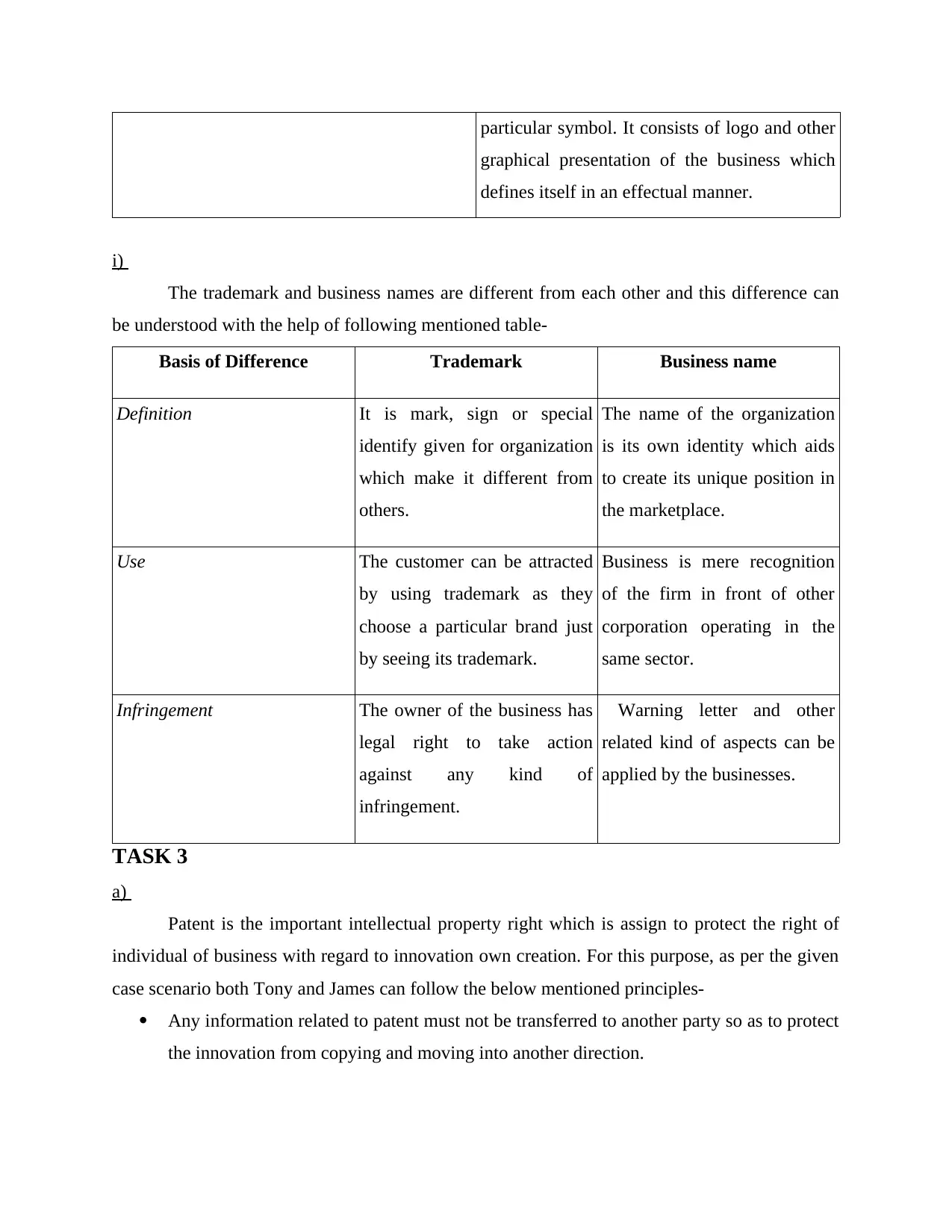
particular symbol. It consists of logo and other
graphical presentation of the business which
defines itself in an effectual manner.
i)
The trademark and business names are different from each other and this difference can
be understood with the help of following mentioned table-
Basis of Difference Trademark Business name
Definition It is mark, sign or special
identify given for organization
which make it different from
others.
The name of the organization
is its own identity which aids
to create its unique position in
the marketplace.
Use The customer can be attracted
by using trademark as they
choose a particular brand just
by seeing its trademark.
Business is mere recognition
of the firm in front of other
corporation operating in the
same sector.
Infringement The owner of the business has
legal right to take action
against any kind of
infringement.
Warning letter and other
related kind of aspects can be
applied by the businesses.
TASK 3
a)
Patent is the important intellectual property right which is assign to protect the right of
individual of business with regard to innovation own creation. For this purpose, as per the given
case scenario both Tony and James can follow the below mentioned principles-
Any information related to patent must not be transferred to another party so as to protect
the innovation from copying and moving into another direction.
graphical presentation of the business which
defines itself in an effectual manner.
i)
The trademark and business names are different from each other and this difference can
be understood with the help of following mentioned table-
Basis of Difference Trademark Business name
Definition It is mark, sign or special
identify given for organization
which make it different from
others.
The name of the organization
is its own identity which aids
to create its unique position in
the marketplace.
Use The customer can be attracted
by using trademark as they
choose a particular brand just
by seeing its trademark.
Business is mere recognition
of the firm in front of other
corporation operating in the
same sector.
Infringement The owner of the business has
legal right to take action
against any kind of
infringement.
Warning letter and other
related kind of aspects can be
applied by the businesses.
TASK 3
a)
Patent is the important intellectual property right which is assign to protect the right of
individual of business with regard to innovation own creation. For this purpose, as per the given
case scenario both Tony and James can follow the below mentioned principles-
Any information related to patent must not be transferred to another party so as to protect
the innovation from copying and moving into another direction.
⊘ This is a preview!⊘
Do you want full access?
Subscribe today to unlock all pages.

Trusted by 1+ million students worldwide
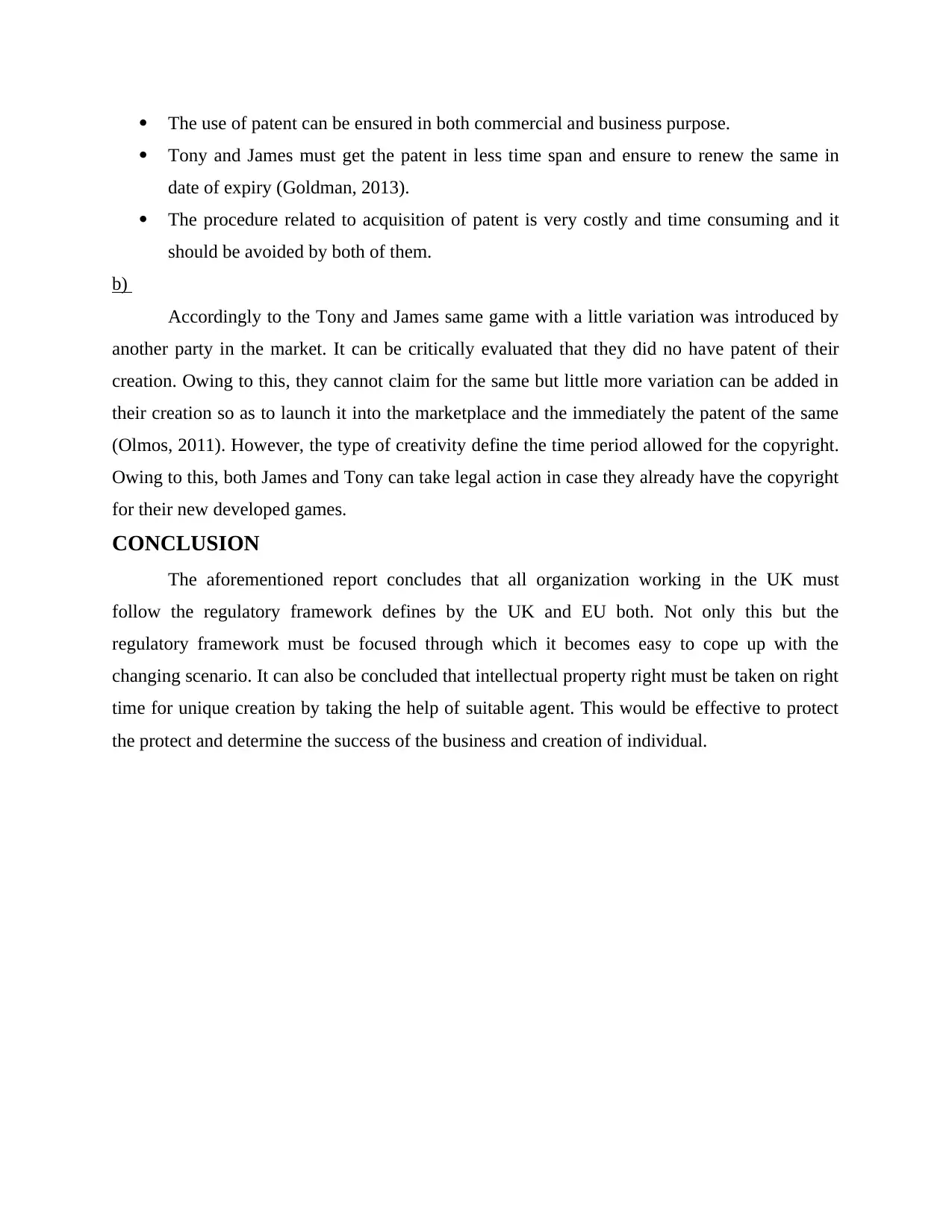
The use of patent can be ensured in both commercial and business purpose.
Tony and James must get the patent in less time span and ensure to renew the same in
date of expiry (Goldman, 2013).
The procedure related to acquisition of patent is very costly and time consuming and it
should be avoided by both of them.
b)
Accordingly to the Tony and James same game with a little variation was introduced by
another party in the market. It can be critically evaluated that they did no have patent of their
creation. Owing to this, they cannot claim for the same but little more variation can be added in
their creation so as to launch it into the marketplace and the immediately the patent of the same
(Olmos, 2011). However, the type of creativity define the time period allowed for the copyright.
Owing to this, both James and Tony can take legal action in case they already have the copyright
for their new developed games.
CONCLUSION
The aforementioned report concludes that all organization working in the UK must
follow the regulatory framework defines by the UK and EU both. Not only this but the
regulatory framework must be focused through which it becomes easy to cope up with the
changing scenario. It can also be concluded that intellectual property right must be taken on right
time for unique creation by taking the help of suitable agent. This would be effective to protect
the protect and determine the success of the business and creation of individual.
Tony and James must get the patent in less time span and ensure to renew the same in
date of expiry (Goldman, 2013).
The procedure related to acquisition of patent is very costly and time consuming and it
should be avoided by both of them.
b)
Accordingly to the Tony and James same game with a little variation was introduced by
another party in the market. It can be critically evaluated that they did no have patent of their
creation. Owing to this, they cannot claim for the same but little more variation can be added in
their creation so as to launch it into the marketplace and the immediately the patent of the same
(Olmos, 2011). However, the type of creativity define the time period allowed for the copyright.
Owing to this, both James and Tony can take legal action in case they already have the copyright
for their new developed games.
CONCLUSION
The aforementioned report concludes that all organization working in the UK must
follow the regulatory framework defines by the UK and EU both. Not only this but the
regulatory framework must be focused through which it becomes easy to cope up with the
changing scenario. It can also be concluded that intellectual property right must be taken on right
time for unique creation by taking the help of suitable agent. This would be effective to protect
the protect and determine the success of the business and creation of individual.
Paraphrase This Document
Need a fresh take? Get an instant paraphrase of this document with our AI Paraphraser
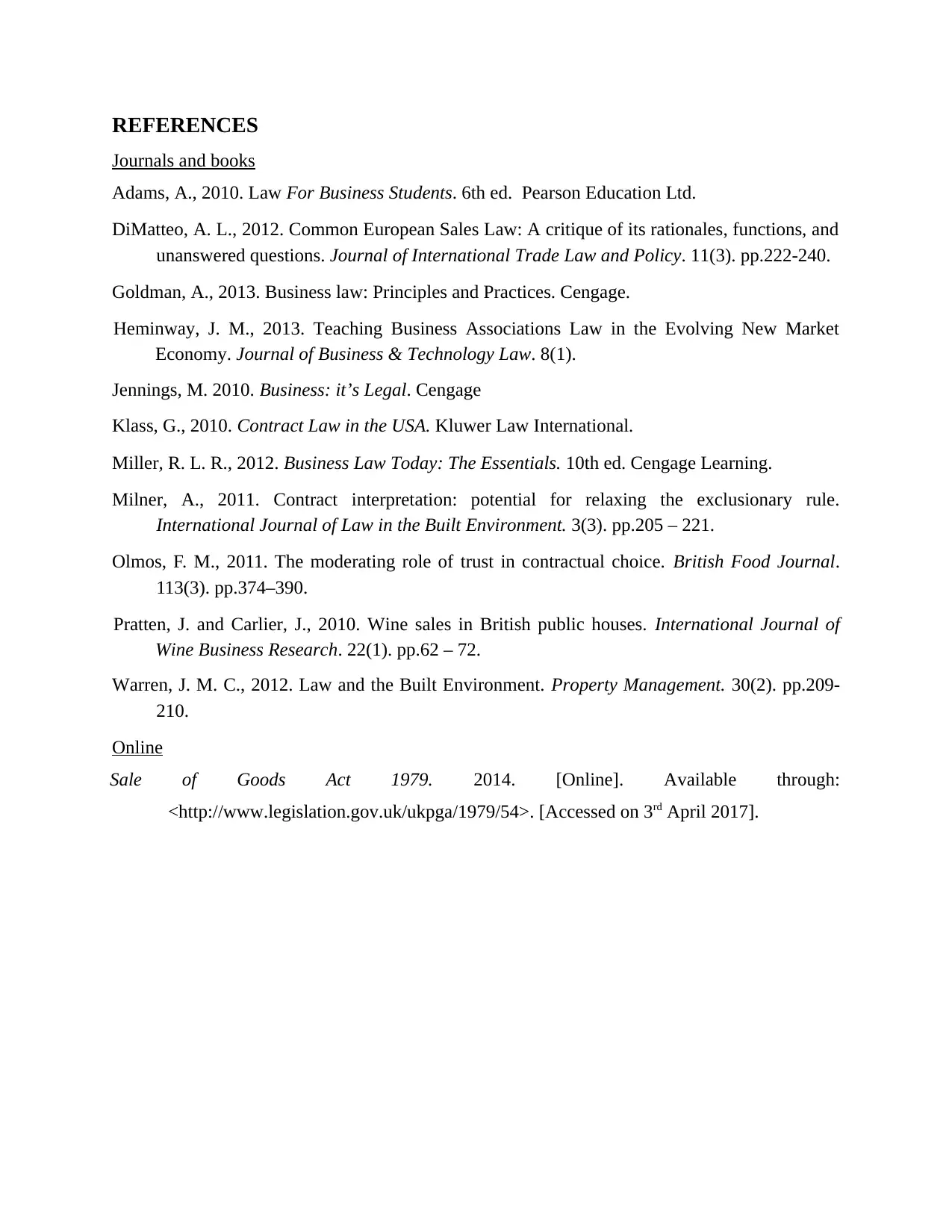
REFERENCES
Journals and books
Adams, A., 2010. Law For Business Students. 6th ed. Pearson Education Ltd.
DiMatteo, A. L., 2012. Common European Sales Law: A critique of its rationales, functions, and
unanswered questions. Journal of International Trade Law and Policy. 11(3). pp.222-240.
Goldman, A., 2013. Business law: Principles and Practices. Cengage.
Heminway, J. M., 2013. Teaching Business Associations Law in the Evolving New Market
Economy. Journal of Business & Technology Law. 8(1).
Jennings, M. 2010. Business: it’s Legal. Cengage
Klass, G., 2010. Contract Law in the USA. Kluwer Law International.
Miller, R. L. R., 2012. Business Law Today: The Essentials. 10th ed. Cengage Learning.
Milner, A., 2011. Contract interpretation: potential for relaxing the exclusionary rule.
International Journal of Law in the Built Environment. 3(3). pp.205 – 221.
Olmos, F. M., 2011. The moderating role of trust in contractual choice. British Food Journal.
113(3). pp.374–390.
Pratten, J. and Carlier, J., 2010. Wine sales in British public houses. International Journal of
Wine Business Research. 22(1). pp.62 – 72.
Warren, J. M. C., 2012. Law and the Built Environment. Property Management. 30(2). pp.209-
210.
Online
Sale of Goods Act 1979. 2014. [Online]. Available through:
<http://www.legislation.gov.uk/ukpga/1979/54>. [Accessed on 3rd April 2017].
Journals and books
Adams, A., 2010. Law For Business Students. 6th ed. Pearson Education Ltd.
DiMatteo, A. L., 2012. Common European Sales Law: A critique of its rationales, functions, and
unanswered questions. Journal of International Trade Law and Policy. 11(3). pp.222-240.
Goldman, A., 2013. Business law: Principles and Practices. Cengage.
Heminway, J. M., 2013. Teaching Business Associations Law in the Evolving New Market
Economy. Journal of Business & Technology Law. 8(1).
Jennings, M. 2010. Business: it’s Legal. Cengage
Klass, G., 2010. Contract Law in the USA. Kluwer Law International.
Miller, R. L. R., 2012. Business Law Today: The Essentials. 10th ed. Cengage Learning.
Milner, A., 2011. Contract interpretation: potential for relaxing the exclusionary rule.
International Journal of Law in the Built Environment. 3(3). pp.205 – 221.
Olmos, F. M., 2011. The moderating role of trust in contractual choice. British Food Journal.
113(3). pp.374–390.
Pratten, J. and Carlier, J., 2010. Wine sales in British public houses. International Journal of
Wine Business Research. 22(1). pp.62 – 72.
Warren, J. M. C., 2012. Law and the Built Environment. Property Management. 30(2). pp.209-
210.
Online
Sale of Goods Act 1979. 2014. [Online]. Available through:
<http://www.legislation.gov.uk/ukpga/1979/54>. [Accessed on 3rd April 2017].
1 out of 11
Related Documents
Your All-in-One AI-Powered Toolkit for Academic Success.
+13062052269
info@desklib.com
Available 24*7 on WhatsApp / Email
![[object Object]](/_next/static/media/star-bottom.7253800d.svg)
Unlock your academic potential
Copyright © 2020–2025 A2Z Services. All Rights Reserved. Developed and managed by ZUCOL.





